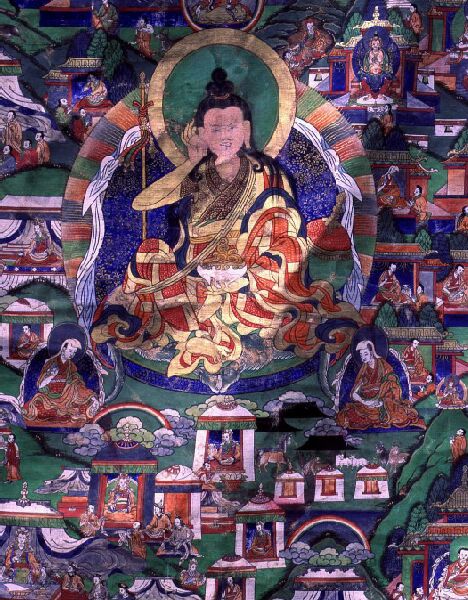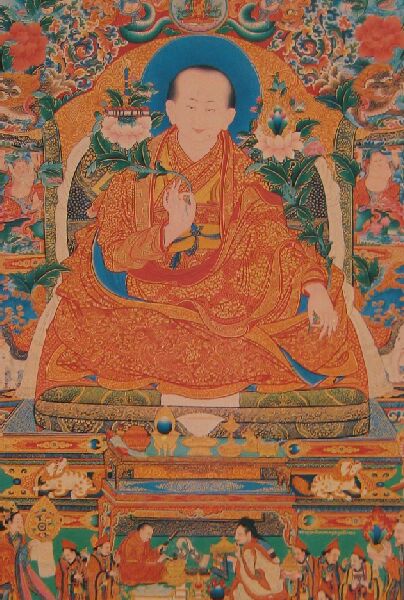Biography and autobiography in Tibet are important sources for both education and inspiration. The authors involved in the Treasury of Lives are currently mining the primary sources to provide English-language biographies of every known religious teacher from Tibet and the Himalaya, all of which are organized for easy searching and browsing. Every Tuesday on the blog, we will highlight and reflect on important, interesting, eccentric, surprising and beautiful stories found within this rich literary tradition. The following summarizes the biography of Zhabkar Tsokdruk Rangdrol written by Matthieu Ricard.
Poet Saints, Part 1: Zhabkar Tsokdruk Rangdrol

Many biographies of the lives of Tibetan religious visionaries include the poetic verses by which they imparted their wisdom and described their experiences. These poems are famous as expressions of a master’s enlightenment and philosophical ingenuity. In this post and the next, we will explore the lives of two of the most famous poet saints of Tibetan tradition: Zhabkar Tsokdruk Rangdrol (1781–1851) and the Sixth Dalai Lama, Tsangyang Gyatso (1683–1706).
Zhabkar Tsokdruk Rangdrol was born in 1781 among the yogins and tantric practitioners of the Rebkong region of eastern Tibet. He entered Zhohong, a community of tantric practitioners at the age of 11, and had his first teachings at the age of 12.
Around 1797 he met Jamyang Gyatso (d. 1800), a lama with both Nyingma and Geluk affiliations, who gave young Zhabkar a number of important Nyingma treasure cycle transmissions including those of Jigme Lingpa (a personage whose life and lineage The Treasury of Lives explored in the Tricycle summer 2013 issue). At that time, Zhabkar studied with the Geluk master Lobzang Tendzin Gyatso (1780–1848) and a painter named Tenpa Dargye. He later ordained at the Geluk monastery of Dobi, in 1801. From there he sought out the Nyingma master Chogyel Ngakgi Wangpo, from whom he received a wide range of teachings, including that which became his central practice, the treasure revelation of Kunzang Dechen Gyelpo (b. 1736) known as The Wish-Fulfilling Gem, Hayagriva, and Varahi. It was during the empowerment that Ngakgi Wangpo gave him the name Tsokdruk Rangdrol.

Following Ngakgi Wangpo’s death in 1807, Tsokdruk Rangdrol practiced for five years in the wilderness of Tsezhung Wenpai Gatsel. He then meditated for three years, from 1806 to 1809, on the small Tsonying Island in the middle of Lake Kokonor, the “Blue Lake” of Amdo. It is here that he began his autobiography, which was not finished until 1837, fourteen years before his death. His search for sacred places took him to many other solitary retreats: the glaciers of Amnye Machen, the sacred caves of Drakkar Treldzong, the “White Rock Monkey Fortress,” the arduous pilgrimage of the ravines of Tsari, Mount Kailash, and the Labchi Snow Range. He spent many years in the caves where Milarepa (1040–1123) and other saints had lived and meditated such as Takmo Dzong, Gopo Dzong and others. Despite his monastic vows, he let his hair grow long and wore the topknot of a tantric practitioner.
Tsokdruk Rangdrol came to be known as Zhabkar Lama, the “White Footprint Lama,” after spending years in meditation at Mount Kailash in a remote spot near the famous White Footprint, one of the four footprints said to have been left by the Buddha when he traveled miraculously to Kailash.
Throughout his remarkable autobiography, Zhabkar uses poetic verse to describe his experiences and conversations, and to express the insights he gained through his practice. An exchange with a student exemplifies the splendor of his writing. While on a demanding pilgrimage to the ravines of Tsari, a student asked Zhabkar if, while alone on retreat, without the circumstances to inspire desire, did desire or lust still arise in his mind. Zhabkar playfully answered that not only did desire arise in him, but he also entertained the craving! Zhabkar’s poem describes his overcoming of desire:
In the pleasure groves of isolated mountains,
The six-legged dancing bee
Is embraced and kissed
By the exquisite lotus maiden.Many young birds,
Bending their graceful necks
And sending each other sidelong glances,
Ride one upon another in their sensuous dance.Seeing this, I, the yogin,
Became inflamed by intense desire.
Uniting inseparably with
The beautiful maiden, the absolute expanse,
I became deeply intoxicated
By the enchanting taste of bliss, clarity, and nonthought.Now, even were I to see a daughter of the gods,
No lust would arise.
The momentary and misleading company of the daughters
Of this perishable world is pointless.
Better to have an everlasting companion like mine,
To grant everlasting happiness.
Zhabkar practiced in retreat for many years in the wilderness of mountain hermitages and then wandered as a homeless yogin throughout Tibet, giving teachings in songs to everyone from bandits to wild animals. His pilgrimages brought him as far as Nepal, where, in the Kathmandu Valley in 1818, he covered the entire spire of the Bodhinath Stupa with gold offered to him by his devotees.
In 1828, at the age of 47, Zhabkar returned to Amdo where he continued to teach until his death in 1851.
Read Treasury of Lives: Poet Saints, Part 2 here.
Poem source: Zabs-dkar Tshogs-drug-ran-grol, Constance Wilkinson, and Michal Abrams.The Life of Shabkar: The Autobiography of a Tibetan Yogin. Ithaca, NY: Snow Lion Publications, 2001. (p. 255-256)